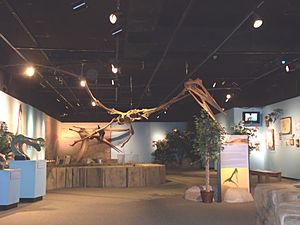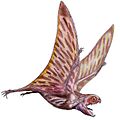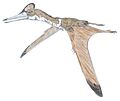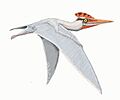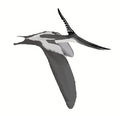Pterodactyloids facts for kids
Quick facts for kids PterodactyloidsTemporal range: Upper Jurassic – Upper Cretaceous
|
|
|---|---|
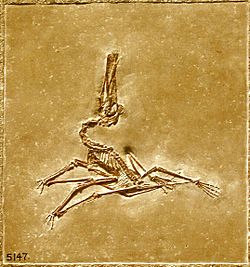 |
|
| Pterodactylus | |
| Scientific classification | |
| Kingdom: | |
| Class: | |
| (unranked): | |
| Order: | |
| Suborder: |
Pterodactyloidea
|
Pterodactyloidea were a group of amazing flying reptiles called pterosaurs. They lived a very long time ago, starting in the late Jurassic period. Unlike some other pterosaurs, Pterodactyloids had short tails.
Some famous Pterodactyloids include Pterodactylus, Pteranodon, and Quetzalcoatlus. These creatures flew through the skies until the end of the Cretaceous period. They disappeared during a huge event called the K/T extinction event, which also wiped out most of the dinosaurs.
Scientists have recently found out that there was more variety among Pterodactyloids than they first thought. In the early 2010s, new types of pterosaurs were discovered from the late Cretaceous. These new finds even included some smaller pterosaur species.
How Scientists Group Pterodactyloids
Scientists group animals based on their shared features. This helps them understand how different species are related. Pterodactyloidea is usually seen as the group of pterosaurs with short tails. They also had long wrist bones (called metacarpals). This was different from older pterosaurs, which had long tails and short wrist bones.
In 2004, a scientist named Kevin Padian gave a more formal definition. He said Pterodactyloidea includes species where the wrist bone is at least 80% as long as the upper arm bone (humerus). This feature is like what is seen in Pterodactylus.
Another group within Pterodactyloidea was named Lophocratia by David Unwin in 2003. This group was named because many of its members had a crest on their heads. However, scientists later found head crests in older pterosaurs too. This means head crests might have been a common feature for all Pterodactyloids.
Scientists use different ways to figure out how these ancient animals are related. These studies sometimes show different family trees for Pterodactyloids. New discoveries and new ways of looking at the bones can change how scientists group these fascinating creatures.
Images for kids
See also
 In Spanish: Pterodactyloidea para niños
In Spanish: Pterodactyloidea para niños


